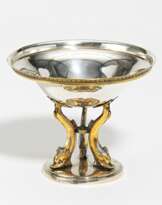ID 647740
Lot 16 | Lidded ivory chalice
Estimate value
€ 20 000 – 22 000
Nuremberg.
Date: Late 17th century/early 18th century.
Technique: Ivory.
Description: Cylindrical, simple body with two circumferential round bar profiles. The lid slightly
protruding with a high knob with a wide disc and a small final spigot..
Measurement: Height 25cm.
Mark: On the bottom, sales label of the New York art dealer Mathias Komor.
Literature:
Klaus, Maurice: The lathe of a nobleman, in: Deutsches Museum [ed.]: Kultur & Technik, 9th Jg., Heft 1, 1985, pp. 15ff.
Syndram, Dirk: Die Elfenbeindrechselei im Grünen Gewölbe - Von der Maschienkunst zum fürstlichen Sammlungsgegenstand, in: Deutsches Elfenbein Museum Erbach [ed.]: Wiedergewonnen. Ivory Pieces from Dresden. A Collection of the Green Vault. Erbach 1995, pp. 6- 13.
The art of ivory turning
With fast turning movements, the particularly homogeneous and valuable natural material ivory was worked into shape on lathes. Through the combination of different motion sequences, artistic products were created. Initially regarded as a purely technical craft, turning increasingly established itself as an artistic, creative pursuit.
From the 16th to the late 18th century, ivory turning developed into a particularly popular pastime among the high aristocracy and also became part of princely education. As a result, numerous ivory turneries found their way into art chambers. "The turned ivory pieces of art became genuine works of the Kunstkammer, collector's items in which mechanics and mathematics were united in beauty."
In order to be able to pursue this occupation in the best possible way, many courts set up their own turning workshops, which were equipped with increasingly complicated machinery as the level of skill advanced. For example, Emperor Rudolf II. (reigned 1576-1612) had his own turning room set up in Prague Castle, and the Wittelsbach dynasty also equipped themselves with such a room in the Munich Residence. Duke Maximilian I (r. 1597 - 1651), later Elector was particularly ambitious in the art of turning. This is evidenced by the numerous works he made and his still preserved turning lathe in the Bavarian National Museum.
Despite the great ambitions of the feudal lords, it was mainly ivory artists such as the Zick family from Nuremberg who knew how to give the material an artistic shape. They are also credited with the invention of contrefait turning.
Err:509
| Auction house category: | Early Works of Art |
|---|
| Auction house category: | Early Works of Art |
|---|
| Address of auction |
VAN HAM Kunstauktionen GmbH Hitzelerstr. 2 50968 Köln Germany | ||||||||||||||
|---|---|---|---|---|---|---|---|---|---|---|---|---|---|---|---|
| Preview |
| ||||||||||||||
| Phone | +49 221 92586215 | ||||||||||||||
| Fax | +49 221 92 58 62 4 | ||||||||||||||
| Buyer Premium | 32% | ||||||||||||||
| Conditions of purchase | Conditions of purchase | ||||||||||||||
| Business hours | Business hours
|











